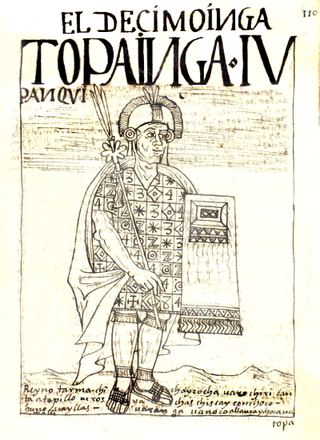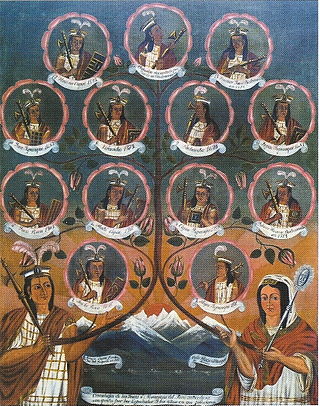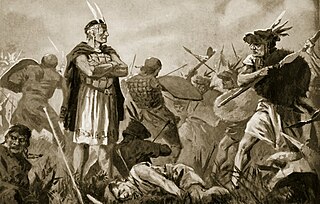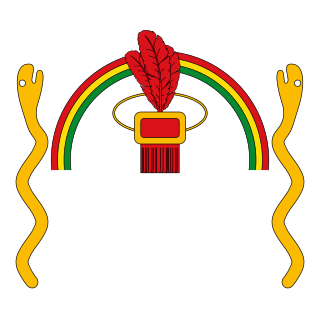
The Inca Empire, officially known as the Realm of the Four Parts, was the largest empire in pre-Columbian America. The administrative, political, and military center of the empire was in the city of Cusco. The Inca civilization rose from the Peruvian highlands sometime in the early 13th century. The Spanish began the conquest of the Inca Empire in 1532 and by 1572, the last Inca state was fully conquered.

Tupaq Amaru or Thupa Amaru was the last Sapa Inca of the Neo-Inca State, the final remaining independent part of the Inca Empire. He was executed by the Spanish following a months-long pursuit after the fall of the Neo-Inca State.

Pachacuti Inca Yupanqui, also called Pachacútec, was the ninth Sapa Inca of the Chiefdom of Cusco, which he transformed into the Inca Empire. Most archaeologists now believe that the famous Inca site of Machu Picchu was built as an estate for Pachacuti.

Atahualpa, also Atawallpa (Quechua), Atabalica, Atahuallpa, Atabalipa, was the last effective Inca emperor before his capture and execution during the Spanish conquest.

Don Diego de Castro Titu Kusi Yupanki was an Inca ruler of Vilcabamba and the penultimate leader of the Neo-Inca State. He was a son of Manco Inca Yupanqui, He was crowned in 1563, after the death of his half brother, Sayri Tupac. He ruled until his death in 1571, probably of pneumonia.

Manqu Inka Yupanki (Quechua) was the founder and monarch of the independent Neo-Inca State in Vilcabamba, although he was originally a puppet Inca Emperor installed by the Spaniards. He was also known as "Manco II" and "Manco Cápac II". He was one of the sons of Huayna Capac and a younger brother of Huascar.

Topa Inca Yupanqui or Túpac Inca Yupanqui, also Topa Inga Yupangui, translated as "noble Inca accountant," was the tenth Sapa Inca (1471–93) of the Inca Empire, fifth of the Hanan dynasty. His father was Pachacuti, and his son was Huayna Capac. Topa Inca belonged to the Qhapaq panaca. His qoya was his older sister, Mama Ocllo.

The Sapa Inca was the monarch of the Inca Empire (Tawantinsuyu), as well as ruler of the earlier Kingdom of Cusco and the later Neo-Inca State. While the origins of the position are mythical and originate from the legendary foundation of the city of Cusco, it seems to have come into being historically around 1100 AD. Although the Inca believed the Sapa to be the son of Inti and often referred to him as Intip Churin or 'Son of the Sun,' the position eventually became hereditary, with son succeeding father. The principal wife of the Inca was known as the Coya or Qoya. The Sapa Inca was at the top of the social hierarchy, and played a dominant role in the political and spiritual realm.

Qhapaq Yupanki Inka was the fifth Sapa Inca of the Kingdom of Cusco and the last of the Hurin dynasty.

Wiraqucha or Viracocha was the eighth Sapa Inka of the Kingdom of Qusqo and the third of the Hanan dynasty.

The Incas were most notable for establishing the Inca Empire which was centered in modern-day South America in Peru and Chile. It was about 4,000 kilometres (2,500 mi) from the northern to southern tip. The Inca Empire lasted from 1438 to 1533. It was the largest Empire in America throughout the Pre-Columbian era. The Inca state was known as the Kingdom of Cuzco before 1438. Over the course of the Inca Empire, the Inca used conquest and peaceful assimilation to incorporate the territory of modern-day Peru, followed by a large portion of western South America, into their empire, centered on the Andean mountain range. However, shortly after the Inca Civil War, the last Sapa Inca (emperor) of the Inca Empire was captured and killed on the orders of the conquistador Francisco Pizarro, marking the beginning of Spanish rule. The remnants of the empire retreated to the remote jungles of Vilcabamba and established the small Neo-Inca State, which was conquered by the Spanish in 1572.

The Inca Civil War, also known as the Inca Dynastic War, the Inca War of Succession, or, sometimes, the War of the Two Brothers, was fought between half-brothers Huáscar and Atahualpa, sons of Huayna Capac, over succession to the throne of the Inca Empire. The war followed Huayna Capac's death.
The Chanka people are a Quechua people ethnic group living in the regions of Apurímac, Ayacucho and Lamas of Peru. They were enemies of the Incas, and they were centered primarily in Andahuaylas, located in the modern-day region of Apurímac. The Chankas were divided into three groups: the Hanan Chankas, or the Upper Chankas, the Urin Chankas, or the Lower Chankas, and the Villca, or Hancohuallos. The Hanan Chankas had their center in Andahuaylas, the Urin Chankas in Uranmarca, and the Villca in Vilcas Huaman, Ayacucho.

The Kingdom of Cusco, also called the Cusco confederation, was a small kingdom based in the Andean city of Cusco that began as a small city-state founded by the Incas around the start of 13th century. In time, through warfare or peaceful assimilation, it began to grow into the Inca Empire (1438–1533).
Pocras were the ancient Wari culture inhabitants of the modern-day city of Huamanga, Peru before the Spanish conquest of the Inca Empire, bounded on the northwest by the Warivilcas, and on the southeast by the Rucanas and the Soras and on the east by the Mayonmarka near the Andahuaylas in La Mar (Chungui) in the current Peruvian province of Ayacucho. This culture was developed in the Middle Horizon and Late Intermediate cultural periods of Peru, from about CE 500 to 1000. Culturally the Pocras were outstanding in pottery, especially that found in Conchopata, Akuchimay, and behind Los Caballitos on the banks of Piñawa, Tenería or contemporary Alameda.

The Neo-Inca State, also known as the Neo-Inca state of Vilcabamba, was the Inca state established in 1537 at Vilcabamba by Manco Inca Yupanqui. It is considered a rump state of the Inca Empire (1438–1533), which collapsed after the Spanish conquest in the mid-1530s. The Neo-Inca State lasted until 1572, when the last Inca stronghold was conquered, and the last ruler, Túpac Amaru, was captured and executed, thus ending the political authority of the Inca state.

The economy of the Inca Empire, which lasted from 1438 to 1532, was based on local traditions of "solidarity" and "mutualism", transported to an imperial scale, and established an economic structure that allowed for substantial agricultural production as well as the exchange of products between communities. It was based on the institution of reciprocity, considered the socioeconomic and political system of the Pre-Columbian Andes.
Auqui was the title held by the crown prince in the Inca Empire or Tahuantinsuyu. In a generic way, all the male children of the Inca were called auquis; however, the specific title was applicable only to one of them, whose choice was based on criteria different from those of the Eastern world because his capacity was taken into account, rather than his status as first-born or legitimate son.
Capac Yupanqui, was the brother of the Inca emperor Pachacuti and an Inca general.

The Colla-Inca War was a military conflict fought between the Inca Empire and the Colla Kingdom between 1445 and 1450. It is one of the first wars of conquest led by Pachacuti.
















